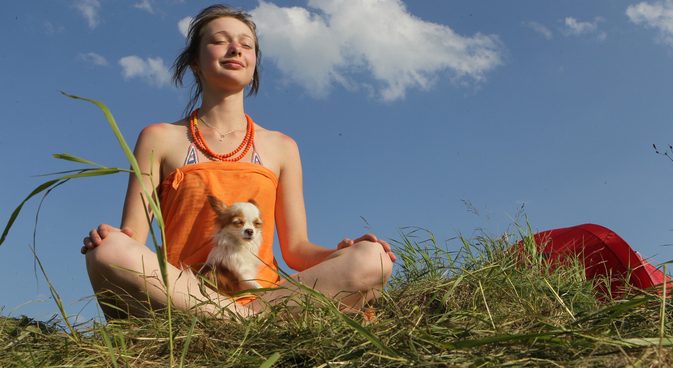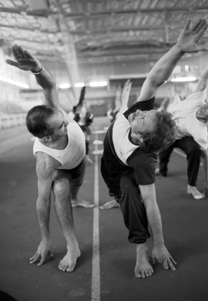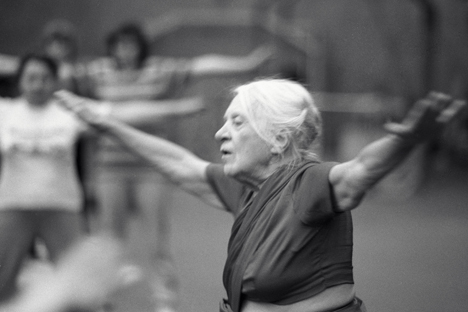
The path of popularising yoga in Russia has been long and windy. Source: AlexeyKudenko / RIA Novosti
Yoga was enjoyed by quite a large number of people in Imperial Russia, and this laid the roots for its absorption into Soviet culture. From the end of the 19th Century and right up until the 1920s, when the USSR was formed, Indian philosophy and yoga were popular amongst the artistic and intellectual communities.
Theatre director Konstantin Stanislavsky famously incorporated several yogic exercises and psychological techniques from the Buddhist tradition into his Stanislavsky System as a means for developing attention and concentration, and also for achieving ‘Solitude in Public’ on stage, which is in essence Dhyana – full concentration.
Another theatre teacher, actor and director, someone who practiced yoga throughout his life and who, in many questions of acting technique, followed behind Stanislavsky, was Mikhail Chekhov (1891-1955).
Right at the beginning of the 20th Century much literature came out on the theme of yoga. The books of American writer William Atkinson, who wrote under the pseudonym Yogi Ramacharaka, were published – works which included: Hatha Yoga, Jnana Yoga, Lessons in Yogi Philosophy and Oriental Occultism, and The Science of Psychic Healing. Besides Atkinson’s works, other published works included Svami Vivekananda’s book on Raja Yoga, Yoga Sutra by Patanjali, which came out with the Russian title of ‘Patanjali’s Aphorisms’, and Bhagavad Gita was also republished.
 |
| Yoga was enjoyed by quite a large number of people in Soviet Union. Source: RIA Novosti |
Interestingly, Bhagavad Gita first appeared in Russia under the reign of Ivan the Terrible (1530-1584). The manuscript was sent to the tsar as a gift from one of the Great Moghuls. Its first translation into Russian (from English and Sanskrit) was published in 1788 by Imperial decree of Catherine the Great and with the endorsement of the Holy Synod (“this book is good for the soul”), with typography by Nikolai Novikov.
Today, the manuscript of the first Bhagavad Gita is kept in Moscow in an archive within the Ministry of Foreign Affairs. Despite these materials being available in Russia, people’s understanding of yoga at the beginning of the 20th Century was still incomplete.
The practice of individual exercises, breathing techniques and meditation was superficial in character and unlikely to lead to the ultimate aim of yoga – Samadhi.
Seller of prana and givers of fire
Then, in 1915, an interesting person appeared in Russia, then on the brink of a Revolution. This man had an indomitable will, he was a mystic and hypnotist, whose knowledge of Eastern philosophy was drawn not just from books, but also from conversation, as he himself liked to say, “from all kinds of different teachers from Asia and the East”.
This man was Georgy Ivanovich Gurdjieff – one of the most dissonant philosophers of the 20th Century. In these years he was only starting to work on his groundbreaking book, Fourth Way, which, as he described it “contains elements of teaching from the yogis, Sufis, Tibetan Buddhism and some Shamanic techniques from various different traditions, including Mongol traditions”.
But the Revolution, and then the Civil War interrupted his plans and he left for the Caucasus, and from there to Europe. In 1922 Gurdjieff opens the Institute of the Harmonious Development of Man at the Chateau Le Prieuré, near Fontainebleau in France.
Contemporary researchers are divided in their views of Gurdjieff’s life and activities. Some believe that he was involved in big political games and had a hand in creating both fascism and Stalinism. This is what French journalist, Louis Pauwels wrote in his biography ‘Monsieur Gurdjieff’.
Meanwhile, in the 1920s in Paris, other Russian emigrants – Nikolai and Elena Roerich are involved in promoting Agni Yoga – creating a new religious and philosophical study of the System of Living Ethics, which claims to be a synthesis of all religions and types of yoga based upon a united spiritual and energetic foundation upon which the world is built, the so-called Spatial Fire.
According to Elena Roerich, books on Agni Yoga were written as a result of ‘clairvoyant conversations’ with Mahatma Moria.
At the end of the 19th Century, another one of Mahatma Moria’s pupils, Elena Blavatskaya, wrote the works ‘Secret Doctrine’ and ‘Isis Unveiled’ based directly on Moria’s teachings.
The Unconquerables
Information about yoga during the dark, harsh, Stalinist times is hard to come by. But yoga was still very much in existence, practiced by a tough core of brave people. These dedicated yogis and yoginis mainly practiced in camps, and yoga was undoubtedly a factor in helping them to survive the inhumane conditions.
One of the most well-known examples is philosopher and writer Dmitry Panin, depicted in Solzhenitsyn’s novel The First Circle in the character of Dmitry Sologdin, who practiced yoga with a singular determination.
“Under Stalin he spent seventeen years in labour camps and survived, when death mowed down other unfortunate prisoners in their thousands”, writes Panin’s friend Yuri Glazkov in his book To the Land of our Fathers.
Tatiana Okunevskaya, one of the most famous and beautiful starlets of the Stalinist period, a lady with whom Lavrenty Beria fell in love, also spent six years in the GULAG. She later told journalists that she had survived thanks to “fresh carrots and yoga”.
When gathering the harvest with the other inmates, she “saved her teeth by knawing on carrots, wiping the dirt on her quilted jacket”. Okunevskaya practiced yoga every day, and kept up the routine for the rest of her life. Right into old age she would stand on her head as part of a daily ritual.
One person who cannot be forgotten for his role in contribution towards popularising the philosophy of yoga in Russia during this difficult time is Boris Leonidovich Smirnov – a surgeon, doctor and academic, who under Stalin found himself as a political prisoner at Ashkhabad.
Having developed a taste for yoga, Smirnov independently studied Sanskrit and in 1939 embarked on a project to translate the great Indian epos Mahabharata into Russian. After years of work he translated eight volumes.
Bhagavad-Gita came out as a translation with commentary in 1956. The Book of Bhishma, which included materials on the philosophy of Sankhya, became available to readers in 1963.
People alive at the time remember that, under Stalin, those who practiced yoga really did focus their attention inwards, towards their core. “People like this show by their example, that yoga is a something between you and your inner self, no-one else is necessary, you are alone in the flow of the practice, and this could happen anywhere, even in a prison camp”, emphasises Larisa Danilina.
“And to some extent all of those who were able to find the strength to look inside themselves and fight against the external circumstances, were true yogis, but they just didn’t know that they could label themselves as such”.
Romantics, physicists and lyricism
If yoga under Stalin was a means of survival, during Khrushchev’s Thaw and at the beginning of the Brezhnev era it became an activity shrouded in romanticism. In 1963 a novel called The Razor’s Edge was published, written by the Soviet fantasy writer Ivan Efremov, who laid out the basic principles of yoga in colourful language, readily accessible to a wide Soviet readership.
Parallel to this, in a journal called ‘Rural Youth’, articles came out about the therapeutic effect of yoga –published by indologist Anatoly Nikolaevich Zubkov, a Hindi specialist, and the first (and probably last) certified teacher of yoga in the USSR.

Yoga attracts people of all ages. Source: RIA Novosti
During the ‘thaw’ years, Zubkov was sent to India on business. There he made the acquaintance of Guruji Shri Ram Kumar Sharmoy (the pupil of Swami Sivananda), and under his tutelage he began to practice yoga.
Upon his return to Russia Zubkov became a real missionary and carried out huge and ambitious work for the popularisation of yoga in the USSR. At the time, promoting yoga, an activity he carried out entirely without commercial interests, required a lot of bravery.
At one point he was even summoned to Petrovka 38 (the Moscow Criminal Police Department). But everything worked out, and in the 1970s Zubkov wrote the script for the first Soviet documentary film about yoga. The title was ‘Indian Yogis. Who are they?’
As director of the Iyengar Yoga Centre, Elena Ulmasbaeva, noted, the screening of this documentary started a “fashion for yoga”. This manifested itself in printing of the books of Indra Devi or some fragments of Yoga Dipika by B.K.S. Iyengar.
In the 1970s yoga also attracted the attention of the government, who invited Dhirendra Brahmachari to the USSR (the Sukshma Vyayama method). According to Mikhail Konstantinov, director of Ashtanga Yoga at the Centre says, the aim of inviting Dhirendra Brahmachari was a scheme to employ yoga techniques in astronaut training. It all happened under the utmost secrecy, none of this was publicised”.
Unknown soldiers
Another, largely hidden chapter in the history of yoga in Russia, is dedicated to all the people who practiced in secret. It is only now, 40 years later, that we are able to find out about this, as these unknown yogis are starting to come out of the woodwork and make themselves known in public.
In particular, a book of memoirs has been published under the title ‘One in the ocean’, by an oceanographer Slava Kurilov, who steadfastly stuck to his interest in yoga in the 1960s, drawing on ‘samizdat’ sources for guidance.
In 1973 the authorities stopped allowing Kurilov to go abroad on business trips, which made his profession as an oceanographer very difficult to fulfil, as much of the research is carried out in tropical seas. It was then that he thought up a unique means of escaping the USSR.
Back then foreign cruises were still popular: people travelled around different seas aboard a cruise liner. And Kurilov decided to jump ship when one of these ships was travelling past the Philippines, two kilometres from the shore.
In terms of his psychological and physical preparation to swim two kilometres Kurilov was in good shape. But the ship changed its route, and Slava ended up not two kilometres from the shore, but 200, absolutely alone in the open sea - nothing with him bar some anti-shark powder.
He swam for three whole days. Any psychologist will say that a normal person could not withstand this physical strain – he would either drown, or go crazy. But Kurilov got there. It was daily, intensive yoga practice that helped him to do this.
A big come-back
“In the 1980s the first yoga groups appeared – sessions were held at people’s flats. I went to practice in one of these flats in 1984”, remembers Elena Ulmasbaeva.
“The practice was led by Boris Evgenievich Golemba. It was only possible to join a group like this through knowing the right people. Generally at that time you got wind of these things through word of mouth, through a bit of detective work. There was no internet. And it was impossible to advertise these things. People were even put in jail for practicing yoga, because, from the Soviet authorities’ point of view, it was a very strange activity. Especially when people were meeting in groups in blocks of flats - what if they had some ulterior motive?”
However, at the end of the 1980s the situation started to gradually change, and thanks to the activity of several academics and scientists, yoga came out of the underground. In those years in Moscow there was a laboratory for studying non-traditional healing methods, and this was the workplace of PhD psychology student Elena Olegovna Fedotova.
The Ministry of Health sent her to India to study changed states of consciousness. She spent time in a number of ashrams and schools of yoga in this country, and on this trip she met B.K.S. Iyengar, who she invited to Russia in 1989 for the first Conference on Yoga.
It was an event at which yoga devotees could at last meet openly, having previously been in hiding. Of course, Fedotova went to meet the Guruji at the airport. It was raining, but when Iyengar came out, she threw herself onto her knees in a traditional posture, and actually ended up right in the middle of a puddle, much to the surprise of airport staff.
Thanks to Elena Fedotova, Iyengar yoga started to gain popularity in the USSR, and then in post-Soviet Russia. Maria Shiffers, a teacher of Iyengar yoga, says that “after the first historical conference, the director of the Paris Institute of Iyengar Yoga, Faeq Biria, started to come to give intensive sessions. What is surprising is that yoga was more than just popular, people were desperately keen to practice and would come to yoga in organised crowds. But at the time there were no props or materials at all. My mother would practice using a clay brick instead of a wooden block. At the seminars we would stretch the muscles in our legs in Supta Padangusthasana using leather belts, and there were no mats – we practiced on cotton blankets”.
Parallel with the development of Iyengar yoga in Russia, Kundalini Yoga has also been catching on. In the words of Natalia Kuzmicheva, director of the Sat Nam club: Yogi Bhajan came for the first time in 1989. And then again in 1992.
And it was then that he gave Yakov Marshak his initiation. Before he became involved with Kundalini Yoga, Marshak specialised in illnesses of the thyroid and pancreas, as well as alcoholism and drug addiction. Yogi Bhajan lived with his pupil Dayal Singkhom in the neighbouring house to Marshak for a whole week.
Russia looks to improve physical education in schools
Yogi Bhajan then gave Marshak his spiritual name – Guru Jivan Singh “Teacher of the Freed Soul”. Fired up with new knowledge, Marshak started to use Kundalini yoga techniques to help drug-dependant teenagers, with great and efficient effect.
From the appearance of the first books on yoga to the founding of the first official yoga schools, the path of popularising yoga in Russia has been long and windy, but not without its interesting moments.
What’s curious is that interest in yoga flared up during the dawn days of the Soviet Union and really took flame during the sunset years of the ‘red empire’. It is hard to imagine how and in what direction yoga would have developed in Russia, if it weren’t for the many years during which yoga was practiced behind closed doors, in an atmosphere of danger and secrecy (after all, yoga was an offence for which you could be put in prison), and also the limited access to information about yoga.
Perhaps the reason traditional schools are so revered in Russia – one feature that makes Russian yoga so different from American yoga, for example, (where contemporary styles are celebrated and multiplying at a fast pace), is the fact that yoga developed and took root during times of hardship.
All rights reserved by Rossiyskaya Gazeta.
Subscribe
to our newsletter!
Get the week's best stories straight to your inbox